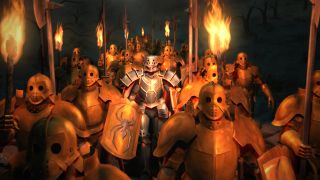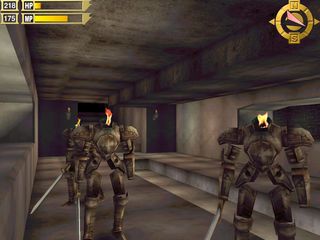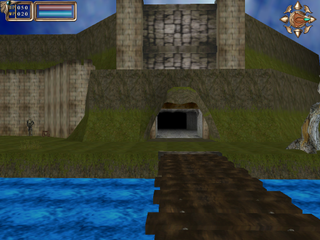Fans are still making sequels to FromSoftware's '90s RPG series
King's Field's 22-year-old construction set is still in use today.

Finding the Eye of Horus and placing it on an altar in Trismegistus is an unforgettable event. The entire world fades away before returning as a warped version of itself, cloaked in ominous purple hues. It feels like the kind of trick Trismegistus just shouldn't be able to pull off, considering how it was made: as an original adventure built with the 22-year-old Sword of Moonlight: King's Field Making Tool, a dungeon crawler construction set released on PC by FromSoftware long before Dark Souls or Elden Ring.
Building a game with FromSoftware's ancient tools took creator Thomas Eversole "multiple hours out of each day" over six months of toil. The effort shows. Strange monsters await your move on a chess-like floor. Serene pools are replaced with fiery lava. The playable duality only becomes more impressive when you realise that travelling back and forth between these skewed reflections is the only way to make any headway. It's the kind of tricky design FromSoftware would appreciate.
Field work
These days being made to wander decaying, obtuse worlds bursting with secrets and unforgiving bouts of combat almost surely means you're playing one of FromSoftware's Souls games. Its PlayStation-born King's Field series, which began in the '90s, paved the way for FromSoftware's later successes. Their blocky models and short draw distances—forgivable considering the original debuted the same year 16-bit console owners were rushing out to buy NBA Jam—gave King's Field not only a distinctive look but also an almost symbolic visual language of its very own. Its worlds existed in a dreamlike state somewhere between being perfectly understandable and eternally inscrutable; herbs, chests, and people always immediately recognisable yet never given enough detail to stop our imaginations from eagerly filling in the blanks.
Everything we have collectively come to cherish in Dark Souls and now Elden Ring can be traced back to these earlier games: they're demanding, stubbornly refuse to give up anything without a fight, aren't afraid to inconvenience anyone playing... and by some arcane magic, that makes them utterly irresistible.
That magic was carefully preserved in the collection of models, textures, settings, and capabilities FromSoftware included in Sword of Moonlight, released for Windows in Japan in 2000. The software appropriately seems to have just as many quirks as the series it came from. "The limitations I encountered all seemed to have an alternative to bypass [it]," says Eversole. "Sword of Moonlight seemed to have a problem with DirectX hardware acceleration and I kept having to toggle it on and off to successfully preview the map and game and use the map editor."

Moonstruck
Eversole discovered that Sword of Moonlight's framerate's would tank depending on how areas were connected. There was, of course, an arcane solution. "If Map 0 led to Map 1, and Map 1 led to Map 2, Map 2 would already be showing some major performance issues, and Map 3 from Map 2 would be completely unplayable, or would crash," he says. But if Map 2 and 3 were connected to Map 0 instead? No problem.
Many fan games made with Sword of Moonlight, like Dark Destiny and Heir of Granatyki, use the software to craft new adventures in old King's Field worlds, expanding on their locations and fragmented stories as prequels to key events in the often hazy timeline. Going through them, with their remarkable FMV introduction sequences, surprising twists, and obvious love for the series baked into every hidden room and deadly chest mimic, feels less like a walk in the past than a gift to the future. It is 2022, there are still new King's Field games out there waiting to be played, and they've been created by people who understand exactly what it is that makes the series so enthralling.
The biggest gaming news, reviews and hardware deals
Keep up to date with the most important stories and the best deals, as picked by the PC Gamer team.
Even MasterTaffer's Return to Melenat—a game that visually echoes the originals so closely it starts you off in the same spot you do in 1995's King's Field 2 (confusingly released in the US as King's Field, since the first game never left Japan)—sparks the imagination. It subtly rebuilds old areas to show them in a whole new light (and to trip up any seasoned hands who wrongly assume they already know how this is going to play out).

Trismegistus is something of an outlier, with more cerebral challenges and outright puzzles that draw from a very different well. "I am a fan of the Myst series as well, and decided to try to make a game like that using Sword of Moonlight," Eversole says, because he wanted to try "pushing the limits" of what it could do. The tonal shift still feels completely fitting, shining a spotlight on King's Field's quiet mastery of environmental storytelling. Every broken pedestal and torch-lit corridor somehow gives the impression they're steeped in lore, and familiar King's Field architecture and enemy models being used in new ways enhances the unsettling feeling that the environment around you is a shattered version of itself.
Games built with Sword of Moonlight may look ancient and rudimentary next to Elden Ring, but there's a reason fans are still drawn to the engine all these years later. There's a real art to working with its limitations: the surrounding murk is meant to be enveloping as much as it is a trick to mask limited draw distances. The slow pace is a feature, not a bug. Even ankle-biting spiders must be treated with a healthy mix of fear and respect. These keepers of the old ways have given us the opportunity to once more wander through worlds gaming has left behind, with new, undiscovered places to explore before they too fade into legend.

When baby Kerry was brought home from the hospital her hand was placed on the space bar of the family Atari 400, a small act of parental nerdery that has snowballed into a lifelong passion for gaming and the sort of freelance job her school careers advisor told her she couldn't do. She's now PC Gamer's word game expert, taking on the daily Wordle puzzle to give readers a hint each and every day. Her Wordle streak is truly mighty.
Somehow Kerry managed to get away with writing regular features on old Japanese PC games, telling today's PC gamers about some of the most fascinating and influential games of the '80s and '90s.
Most Popular


